There is a separate page on the HF 4WD & integrale.
In 1980 it was awarded 'Car of the Year'
by the panel of international motoring journalists.
In 1982 the LX, a 'luxury' model, and a
3 speed automatic transmission were introduced and the 1300 engine received
a minor power increase. More significantly, towards the end of that year
the range was revised again. The 1300 gained the five speed gearbox, the
1500 became available only with the automatic gearbox and the 1600GT was
introduced, using the 1585cc dohc engine from the Beta, tuned to give a
little more power (105bhp) and fitted with disc brakes all round.
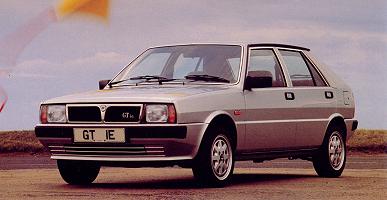 Formally
presented for the first time at the Frankfurt Motorshow in September 1979,
the Lancia Delta was designed by Giugiaro to fit around the mechanicals of a Fiat
Strada/Ritmo
and to replace the Fulvia (already out of production)
as Lancia's 'small' car. Many changes were made to the basic Ritmo running
gear - the engines were reworked to improve the power outputs, and the
suspension from the Beta was adapted to fit to
the Ritmo floorpan. Initial production vehicles were fitted wth either
a 1300 (actually either 1299cc or 1301cc) engine with a four speed gearbox
or a 1500 (1498cc) engine with a five speed gearbox .
Formally
presented for the first time at the Frankfurt Motorshow in September 1979,
the Lancia Delta was designed by Giugiaro to fit around the mechanicals of a Fiat
Strada/Ritmo
and to replace the Fulvia (already out of production)
as Lancia's 'small' car. Many changes were made to the basic Ritmo running
gear - the engines were reworked to improve the power outputs, and the
suspension from the Beta was adapted to fit to
the Ritmo floorpan. Initial production vehicles were fitted wth either
a 1300 (actually either 1299cc or 1301cc) engine with a four speed gearbox
or a 1500 (1498cc) engine with a five speed gearbox .
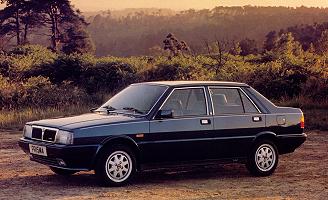 In that same year was born the Lancia Prisma - a three-box saloon designed by Giugiaro
based on the Regata floorpan (the saloon
version of the Ritmo) and using the Delta mechanicals.
In that same year was born the Lancia Prisma - a three-box saloon designed by Giugiaro
based on the Regata floorpan (the saloon
version of the Ritmo) and using the Delta mechanicals.
The Delta HF turbo followed in 1983, introducing
a 1585cc dohc turbocharged engine producing 130bhp, still fitted with a
carburettor. And a year after that Lancia introduced a diesel engine into
one of their cars for the first time when the Prisma diesel, fitted with
a 1929cc Fiat derived engine, was launched. A year later a turbocharged
diesel also became available.
In 1986 the whole Delta/Prisma range was
facelifted and relaunched. The 1300 and 1500 models were revised, whilst
the 1600 gained fuel injection to become the GTie (with 109bhp). The HF
turbo also gained fuel injection (140bhp) and was replaced at the top of
the range by the new HF4WD which had a 1995cc turbocharged engine producing
165bhp and four wheel drive. There was also born a Delta diesel - with
the same turbocharged 1929c engine as the Prisma diesel, and an 1116cc
(FIAT) engined Delta for the Greek market.
In 1987 Lancia entered the World Rally
Champioship with the new HF4WD and immediately won the title. It continued
to win the titles in 1988, 1989, 1990, 1991 and 1992 as the car evloved
from HF4WD to HF integrale to Evolution. The integrale first appeared in 1987
with an 8v engine and 185bhp (in road trim). 1989 saw the
introduction of 16 valves, a new turbocharger and a corresponding increase
in power to 200bhp. The Evoluzione (unofficial term) emerged in 1991 with a wider track,
a rear wing, slight design changes inside and out and a power output of
210bhp. The final version, the Evo 2, gained a catalytic converter, new
turbocharger, new wheels and yet another 5bhp.
For the full story and details of the integrale see our dedicated page.
And we mustn't forget the
Delta S4, Delta only in name, but a great car by every standard.
In 1989 the production of the Prisma ceased,
but the Delta carried on. In 1991 the range was again revised, the 1300
engine was discontinued and various detail changes were made to the grille,
lights, trim levels and wheels. Production of the two-wheel drive Delta's
ceased in 1993 whilst Integrales were produced until 1994 (the last ones by Maggiore).
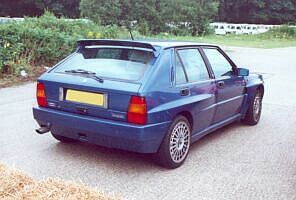 The Prisma range was also revised, the Prisma 4WD actually entering production
before the Delta but only being fitted with a normally aspirated 1995cc
engine (115bhp). The 1300 and 1500 engines were revised as in the Delta.
The Prisma range was also revised, the Prisma 4WD actually entering production
before the Delta but only being fitted with a normally aspirated 1995cc
engine (115bhp). The 1300 and 1500 engines were revised as in the Delta.
Technical Details
| Driveline | transverse engine at front with front wheel drive or four wheel drive |
| Engines | 1301cc (86.4x55.5mm) sohc 4 cyl with 78bhp @ 5,800rpm
1498cc (86.4x63.9mm) sohc 4 cyl with 80bhp @ 5,800rpm GTie : 1585cc (84x71.5mm) dohc 4 cyl with 108bhp @ 5,900rpm HF turbo : 1585cc (84x71.5mm) dohc turbocharged 4 cyl with 140bhp @ 5,500rpm (injected version) 1929cc (82.6x90mm) sohc turbocharged 4 cyl diesel with 80bhp @ 4,200rpm |
| Suspension | front : MacPherson strut with telescopic dampers and coil springs plus anti-roll bar
rear : MacPherson with telescopic dampers and coil springs, located by twin transverse and single trailing links wheelbase : 2475mm track (front/rear) : 1500, GTie, turbo : 1402mm/1400mm |
| Brakes | front : discs (ventilated on some models), diameter 227mm (base models) & 257mm (quicker versions)
rear : drums 185mm diameter (227mm diameter discs on some models) handbrake operating the rear callipers via cable dual hydraulic circuit with servo assistance ABS optional on some models |
| Gearbox | 4 or 5 speed manual
3 speed automatic |
| Steering | Rack and pinion |
| Kerb weight | Delta 1500 (1979 model) : 975kg
Delta GTie : 995kg Prisma 1300/1500/1600 (empty) : 950kg / 955kg / 990kg |
| Dimensions | Delta GTie, Prisma 1.6ie, |
Performance
| model | max speed | 0-100km/h | standing km | Braking (from 100km/h) |
| 1300 (1982) | 160 km/h | 12.8 sec | 34.6 sec | 72 m (from 120km/h) |
| 1500 (1979) | 165 km/h | 33.5 sec | ||
| 1600 GTie (1988) | 186 km/h | 9.8 sec | 31.3 sec | 43.7 m |
| Prisma 1300 | 161 km/h | 12.6 sec | 34.5 sec | 46.5 m |
| Prisma 1500 | 168 km/h | 11.7 sec | 233.5 sec | 50.3 m |
| Prisma 1600 | 183 km/h | 10.2 sec | 31.8 sec | 46.1 m |
Tuning
There are three main areas to concentrate on, the engine (and transmission), the brakes and the suspension and then various other details. These three should be done together since they complement each other, not all of one and none of another !
1. The engine.
Before modifying the engine it is worthwhile
filling it with a good quality synthetic oil and fitting new spark plugs.
An engine oil additive may also be used.
The first improvements are relatively simple.
The air filter can be replaced for an aftermarket item which will help
the engine breathe more freely, the type which completely replace the original
airbox are best, and the exhaust can be replaced for one which will restrict
the exit of the gases less. The whole system should be replaced, not just the rear section.
On other cars (and also a possibility on
electronically controlled cars) the best option is to fit larger carburettors
- preferably two twin units, giving one venturi per cylinder. Sidedraught
DCOE's are popular for this engine and will provide a good increase in
power (as well as a major increase in fuel consumption!). A camshaft change
will also significantly improve the power and torque, but attention must
be paid to the characteristics since some camshafts, usually those with
the best absolute figures, are not very driveable except on a race circuit.
On the Delta turbo's the job of increasing
the power is even easier, fitting a bleed valve will result in significant
gains, but do not be tempted to raise the boost pressure too far or the
fuelling will not be able to cope and the engine will run weak. Water spray
on the intercooler is also worth considering, switched by either an air
temperature sensor (the ideal solution) or bay a MAP sensor (the easy solution).
Consider also adding an octane boosting product to the fuel on cars with
increased boost levels, it will help the ignition cope.
Other things to do should include fitting
a cold air intake, a large diameter pipe (minimum 5cm) to provide air from
outside the engine bay to the air filter. The exhaust manifold can also
be lagged with thermal cloth or tape to keep the exhaust gases hotter (and
thus reduce back pressure) and also to keep the underbonnet (and hence
intake and fuel) temperatures lower.
Further modifications require the machining
of the cylinder headand/or cylinder block (which will not be dealt with
here since it is not normally a DIY job) after which it may be worth fitting
an oil cooler. If overheating is a problem due to the increased power output
then a small hole can also be drilled through the plate in the thermostat.
There are a multitude of company's with experience of internal cylinder
head modifications for the Lancia twin cam engine so it should be possible
to find one wherever you are.
Regarding the transmission the main requirement
is to uprate the clutch to handle the increase in power and torque achieved
though the engine modifications. Friction plates can be purchased with
improved materials and heavier duty pressure plates are also available.
Whilst doing this it is worthwhile lightening the flywheel.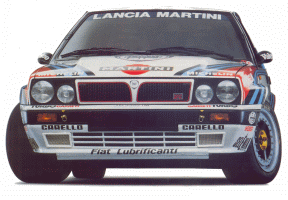 On those cars with electronic injection and ignition, probably the most effective
modification (short of engine rebuilds!) is to replace the electronic control
unit (or 'chip'). For the Integrale availability of off-the-shelf units
is quite good, but for other models useage of a unit designed for any engine
is probably required which will mean some programming and useage of a rolling road.....
On those cars with electronic injection and ignition, probably the most effective
modification (short of engine rebuilds!) is to replace the electronic control
unit (or 'chip'). For the Integrale availability of off-the-shelf units
is quite good, but for other models useage of a unit designed for any engine
is probably required which will mean some programming and useage of a rolling road.....
The high tension leads can also be replaced with performance ones.
2. The brakes.
Initially it is relatively easy to replace
the brake discs with drilled and grooved items, and the pads for a harder
compound. The latter should not be too hard (ie no race pads on the road)
or they will not function effectively at the normal 'road' operating temperatures.
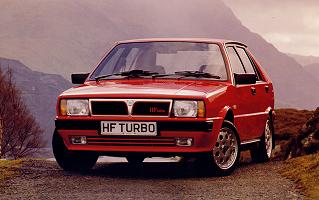 Stainless
steel braided flexible hoses will improve the pedal feel and reduce the
chance of damage whilst DoT5 fluid (not silicon) will increase the temperature
at which it can operate effectively. If the brakes are getting too hot
the dustguards can be removed and/or ducts fitted, taking air from behind the front bumper.
Stainless
steel braided flexible hoses will improve the pedal feel and reduce the
chance of damage whilst DoT5 fluid (not silicon) will increase the temperature
at which it can operate effectively. If the brakes are getting too hot
the dustguards can be removed and/or ducts fitted, taking air from behind the front bumper.
If more serious braking is required the next modification would be to increase the disc size. It is possible to use larger discs with a bracket allowing use of the production callipers, or alloy four pot callipers can be fitted. Lesser models can of course use the components from the more potent family memebers.
In order to improve the balance of the car under braking it is desireable to be able to adjust the balance of braking from front to rear (and vice versa). This can be accomplished by fitting a bias valve in the line to the rear brakes, usually in a position so that it can be reached from the drivers seat.
3. The suspension.
The easiest improvement,and the one which
will probably bring the single most noticeable change, is to replace the
dampers and springs. Fitting lowered springs will improve the cornering,
but must be fitted together with shortened throw dampers, or else the springs
may unseat ! Top adjustable dampers are compromised, but are good for road
and track day cars since it allows the suspension to be adjusted between
these two, rather different, requirements. Coil over units add more adjustability
and can be purchased outright, or can be made from standard dampers by
welding a threaded sleeve to the standard tube.
There are then two other main suspension
aims; to reduce the flexiblity in the suspension and to increase the stiffness
of the car, Into this category also fall the choice
of wheels and tyres. With an increase in power it can be necessary to fit
larger tyres (thus requiring larger wheels) but the temptation to fit the
biggest possible should be resisted. Consideration should be given to fitting
a wider tyre on the front (since they provide traction and steering) but
keeping the standard, or a wider but not as wide as the front, tyre at
the rear. This will improve the balance of the car.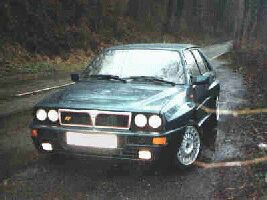 both
of which aim at more accurate control of the wheel movement. To reduce
the flexibility it is possible to fit nylon bushes instead of the normal
production rubber items, or if perfection is desired the suspension can
be fitted with metallic bearings (rose joints / rod ends). Spherical bearing
top mounts can also be used. To stiffen the car it is most popular to fit
strut braces. These can be fitted to the front and rear. For more extreme
cases a rollcage can be fitted.....
both
of which aim at more accurate control of the wheel movement. To reduce
the flexibility it is possible to fit nylon bushes instead of the normal
production rubber items, or if perfection is desired the suspension can
be fitted with metallic bearings (rose joints / rod ends). Spherical bearing
top mounts can also be used. To stiffen the car it is most popular to fit
strut braces. These can be fitted to the front and rear. For more extreme
cases a rollcage can be fitted.....
4. other things.
Other modifications worth considering include fitment of a shift light (and rev limiter if there is not one as standard), higher power bulbs in the headlights (if you are going to go faster you need to see further) and installation of a quicker steering rack.
Buying / Selling
Integrales are one thing, other Delta's
another story ! The HF turbo offers excellent performance at a very low
price. The other normally aspirated Delta's are now at rock-bottom prices
and if one can be found in reasonable condition it is a pleasant and practical
car. With a bit of tuning any Delta can be made to be quick and safe enough
for everyday motoring - see above.
Some tips to do before selling :
(they may seem obvious, but most people don't do them and thus are in a
weaker bargaining position)
Tidy inside the car thoroughly : hoover
the floor, empty all pockets, ashtrays (wash), glove compartment etc...,
wipe the trim with a damp cloth, give the cockpit a good airing to get
rid of any odours ! Reset the trip meter to 00000 - it is a pleasant (subconcious) surprise.
'Back to black' products are very effective
at temporarily restoring bumpers and trim. This makes a big difference
to any car. Do it a week before you expect people to view the car, otherwise
it may be a bit too obvious !
Jetwash under the car, especially under
the engine and in the wheelarches. The prospective buyer may be an enthusiast,
and this makes it easier for them to see what they want to check.
Obviously wash the car and clean the windows !
If you are going to buy a car always
check the following :
Especially neccessary on Delta's is to
check the bodywork. Pay special attention to the wheelarches (inside if
there is no plastic splash guard), suspension and engine mounts, sill,
door pillars (check for sagging doors), scuttle panel and the floor (doors,
bonnet and boot/hatch are also susceptible, but are more easily replaced).
If a sunroof is fitted check around the edge for signs of rust. Especially on Integrales it is
essential to check for accident damage. Check that
there are no mismatching panels, large areas of discolouration or signs
of fresh paint. Look closely for signs of cracking or distortion where the pillars meet the roof.
There should be a colour code sticker on the underside of the bonnet and some
original stickers on the front cross-panel. If possible check the front anti-roll bar mounts, these can fail.
Check for a damp carpet or the presence
of mould - if the carpet is damp then the floor is almost certainly corroded.
Check the main electrical functions - wipers,
windows,lights etc... try putting the main beam and wipers on at the same
time. Check the headlight reflectors for rust.
The engine should be run up to temperature,
check the exhaust for smoke (especially on turbocharged models), the condition
of the breather (look for mayonnaise), the condition of the oil filler cap
(again white deposits can indicate head gasket or other serious problems)
and the colour of the coolant (preferably not brown!). If it has an oil
pressure guage this should not drop below 1 bar at idle, and should be
around 3 to 4 bar at speed. Listen to the noise of the engine, then depress
the clutch and engage first gear. Whatever noise has disappeared was coming
form the gearbox, what remains is from the engine. Check the colour of
the oil using the dipstick. A golden-brown is best, darker brown is ok,
but thick and black should be avoided.
Check tyre wear, uneven patterns could imply a bent chassis.
Always take it for a test drive. Check
that the car tracks in a straight line with no steering input. Find a large
open area and complete several lock to lock turns (also in reverse), listening
for any noises. Try the handbrake when moving - seized rear callipers will
mean uneven braking or no braking.
Generally, Lancia Delta's are mechanically
pretty good, but before the mid 1980's the bodywork was weak. Integrales are the best buy, but beware thrashed and accident repaired examples.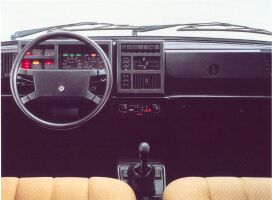 If
the car has been standing give it a good run - this will clear out the
engine (reduce exhaust smoke), put a shine on the brake discs and loosen
up any joints that may otherwise make some noises.
If
the car has been standing give it a good run - this will clear out the
engine (reduce exhaust smoke), put a shine on the brake discs and loosen
up any joints that may otherwise make some noises.
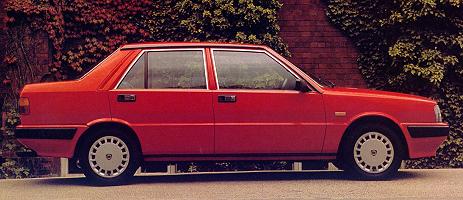 Check
the brake pedal does not go to the floor if pressed hard for a long time
and check the gearchange for clean engagement.
Check
the brake pedal does not go to the floor if pressed hard for a long time
and check the gearchange for clean engagement.
Lancia Delta Books :
buy
them online here (in association with
Amazon)
 Lancia
Road Test Book : Lancia Delta Gold Portfolio 1979-94 Lancia
Road Test Book : Lancia Delta Gold Portfolio 1979-94
Covers the Prisma (1500, 1600, ie, LX) and Delta (1300, 1500, auto, 1600, GT, HFturbo, 4WD, Integrale, 16V and Evoluzione). Over 300 illustrations. |
Edited by R.M.Clarke, 1995 |
For more books Lancia's, see our Online Bookstore
Delta comment form
Your Comments
I
bought a 1988 Delta 1600 GTie last year. It had 40000 miles on the clock,
and it has now 75000. The engine, the gearbox are still Ok, but I have
problems with rust : around the windshield, on the doors, and inside the
front wheel arches. I also had problems with leaks: engine, cooling system
and transmission arms, but all this is Ok now. The clutch was changed at
50000 miles, and the car work pretty well now. Front shock absorbers were
changed at 65000 miles, the exhaust at 55000 and font discs at 60000 miles.
Lancia Delta is the greatest
car in the world. Delta has perfect design and excellent acceleration.
I really love this car! (Steelgar, Russia)
Comments: I bought a 1989
Delta 1.9 TDI six years ago.It had 113.000Km on the clock,and it has now
209.000Km. At 120.000Km I had replaced old engin with another one, old
too.The engine is now still working like new! I have probems with rust
around the windshield,on the doors, back dor at the roof,and inside the
front whellarches.I also had problems with hand brake steel wire, doorhandle,
transmission arms,and many many more litle things. I love this car so much,
and is not problem to repaire it by my self at all.
The Lancia Delta HF Turbo
ie is a pain with all the maintenance and bills and tlc required but each
time you jump in it and drive it it puts a smile on your face and you remember
why you love it so much but not as much as the lovely wife of course! By
the way, overboost is crazy!
My name is Mark and I own
a Lancia Prisma 1.6ie.There ive said it, but finally the car that has caused
me so much ridicule from my "friends" may give me some driving pleasure.
Let me explain, ive owned the car for 4 years and its been sitting in the
driveway for 3 of these, waiting for welding. Well now its done, MOT'd
and back on the road. I had almost forgotten how much of a good drive the
car actually is.It's quick, sounds great, handles well but above all it's
a Lancia. Something different that shouts individuality. A Lancia on the
driveway really says something about the owner. To sum up, I love them.
Im hooked. And I may just be tempted to trade mine in for an Integrale.
Long live Lancia!!!!
I appreciate its very revvy
engine, its excellent roadholding, its good recaro seats and its equipement.
It accelerates from 0 to 60 in 9secs, its top speed is 118, and generally,
it runs 35 mpg. But it's a bit too noisy, it rusts, its steering is awful
and it needs to be maintained very carefully. I can tell you this car has
an excellent resistance against shocks, which explains why bumpers are
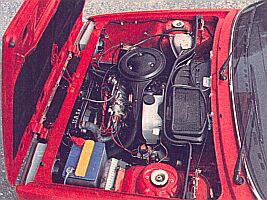 so expensive : 3000 frs, paint included. I paid my car 11000 frs and i'm
very pleased with it. The main problem is the availability in spare parts
: brown-tinted windows are impossible to find ( only green ), but I don't
wish i had bought another car. (Stéphane, France)
so expensive : 3000 frs, paint included. I paid my car 11000 frs and i'm
very pleased with it. The main problem is the availability in spare parts
: brown-tinted windows are impossible to find ( only green ), but I don't
wish i had bought another car. (Stéphane, France)
To Lancia company : Delta
was the best car you ever made in your factory and I`m proude that I have
it !! (L.M.,Slovenija)
![]() There is also a list of all our picture galleries (including museums, motorshows and various events).
There is also a list of all our picture galleries (including museums, motorshows and various events).
Wallpapers/Desktop Backgrounds of numerous Lancia's, including the Delta & Integrale, are available to download.
See also our Lancia advertisements gallery, where several period magazine adverts can be seen.
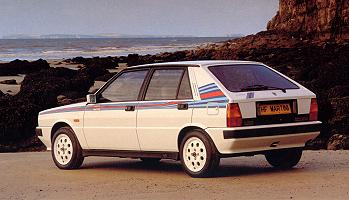
Use the buttons at the top to navigate further, or
Copyright © 2000 to 2011 CarsfromItaly